Art & Exhibitions
Museums Have Been Cautiously Reopening Across Europe. Here Are 8 Must-See Shows You Can Actually Visit in Person Right Now
Check out a Phyllida Barlow survey, a group show about nature, a Sophie Taeuber-Arp retrospective, and more.
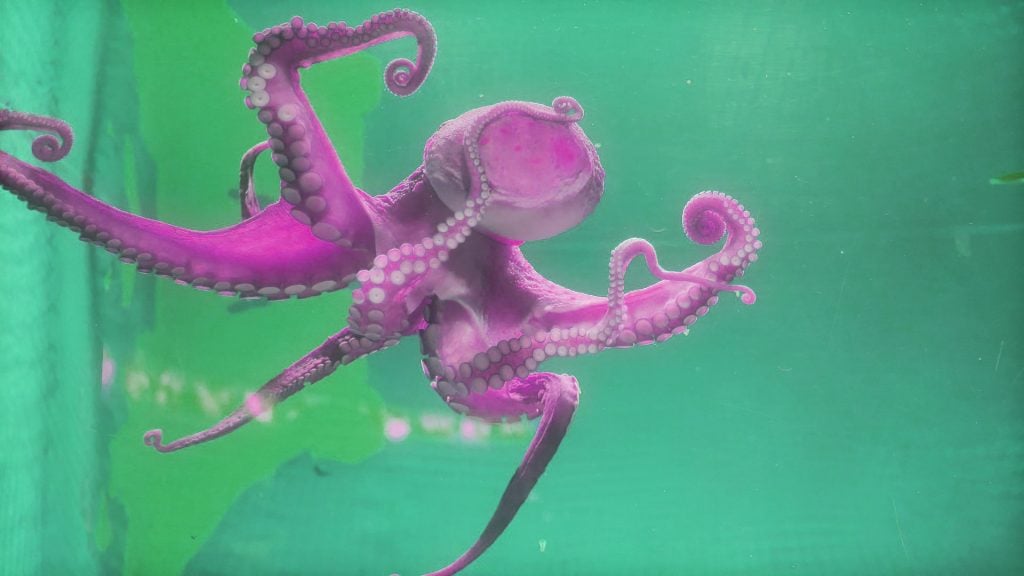
Check out a Phyllida Barlow survey, a group show about nature, a Sophie Taeuber-Arp retrospective, and more.

Kate Brown &
Naomi Rea

As spring nears, some European countries are seeing a small, if temporary, reprieve after months of strenuous lockdown. Museums in Germany, Switzerland, Belgium, and parts of Italy and Scandinavia, are again welcoming visitors to the shows that they’ve been planning, in many cases, for years.
Rifts in society and a still-raging pandemic have been difficult to process, but art—be it historical figures like the Belgian conceptual artist Jef Geys (whose work will be on view in Norway) or the long-overlooked Brazilian artist Leonilson (showing in Berlin), who both broke boundaries in distinct ways—can teach us how to think beyond the challenges of the past year. Newer artists, like Lydia Ourahmane, and intergenerational group exhibitions offer fresh perspectives on society, culture, and nature. And there is little that could substitute the visceral experience of standing within a triumphant installation like Phyllida Barlow’s at Haus der Kunst in Munich.
Here are nine exciting exhibitions in Europe that are—as of publication—actually open and worth a visit, so long as it is safe to do so.
Through April 5
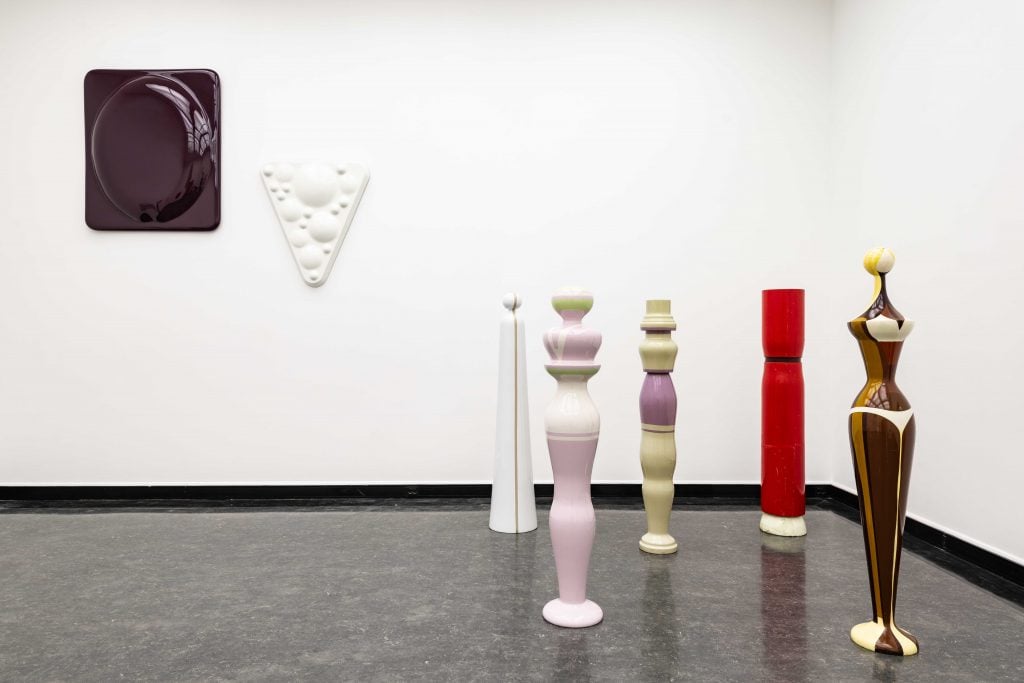
Installation view of Jef Geys at Bergen Kunsthalle. Photo: Thor Brødreskift
The show is the largest presentation of the late Belgian artist’s work in nearly two decades, and the first of its scale since his death, in 2018, at age 83. Geys was a hero among the European avant-garde and never liked to define himself as an artist. His tongue-in-cheek practice often rejected the conventions that defined the art world. He responded, for example, to an invitation to a show with a threat to blow up the institution—which he did not do. He always abstained from attending his openings and declined interviews.
At Bergen Kunsthall, Geys’s survey shows the artist’s wit and the way he drew out wonder in the banal. In his “Seed Bag Series” paintings, for example, Geys rigorously painted large replicas of a packet of seeds that he planted in his garden once a year between 1963 and his death. In other works, he deals in humankind’s mundane desire to aggrandize itself. Corporeal-sized figures are perfectly covered in shiny auto paint manufactured for BMW cars, which, according to Geys, are “one of the most important extension pieces of our body.”
Through March 28
The title of this group show, which translates to “let’s risk it all,” is actually the name of a small town on the Belgian-French border that has been known historically as a through-point for immigrants of all sorts. Some 38 artists from the surrounding regions of the Benelux, including some of the most exciting artists based in and around Europe, are involved in this daring show that investigates ideas of “bridging, passing, translating, and transgressing.” That includes breaking through borders, but also tech-induced information bubbles, and safety nets.
Neïl Beloufa, Tarek Lakhrissi, Laure Prouvost, and Nora Turato are among those taking part in “Risquons-tout,” which occupies the whole of the WIELS building and extends into neighboring spaces around it, ultimately examining “how art challenges the homogenization of thought in the now-infamous echo chambers of our overcrowded info-sphere.”
Through May 16
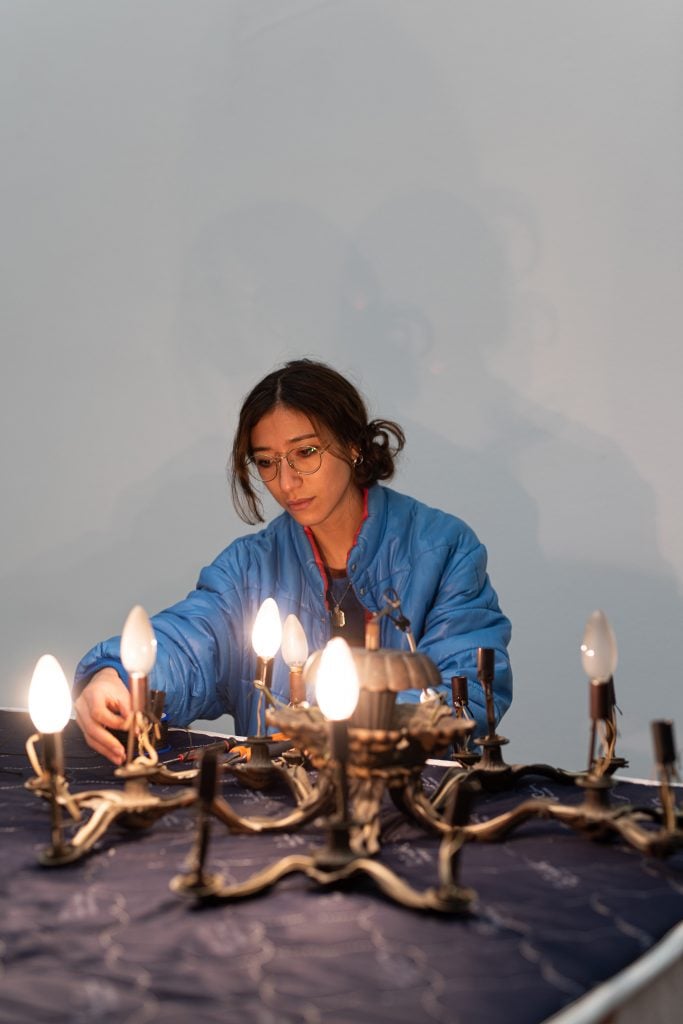
Lydia Ourahmane during install of the exhibition “Barzakh,” Kunsthalle Basel, 2021. Photo by Dominik Asche / Kunsthalle Basel.
The Kunsthalle Basel has commissioned up-and-coming artist Lydia Ourahmane to create a new commission for its upper floor. For her first institutional solo show in Switzerland, the artist has placed new sculptures and sound works among a seemingly innocuous grouping of furniture. It all comes from her rental apartment in Algeria, which had been furnished by its deceased former occupant.
From photographs to dinnerware to chandeliers, the once private space is made public in this exhibition and, meanwhile, the space is rigged with bugging devices that record the visitors’ movements. Together, the installation probes notions of home, settlement, and claiming space, as well as discipline through regimes of surveillance, invoking at once histories of displacement and colonial systems of oppression.
Through May 24
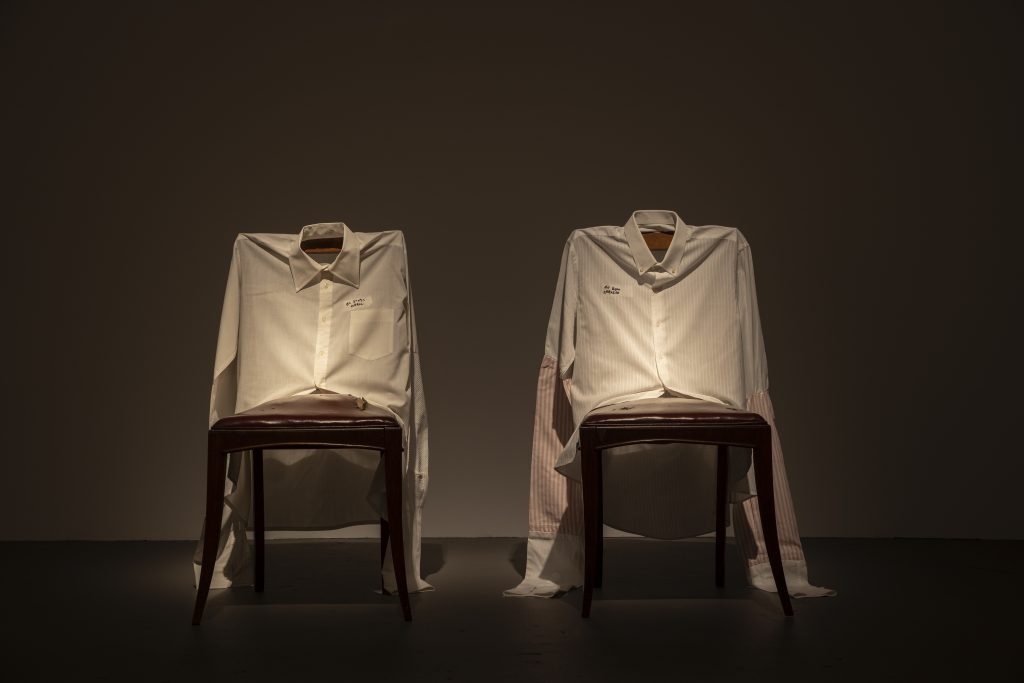
Da falsa moral and Do bom coração both (1993), on view as a part of Leonilson “Drawn 1975–1993” at KW Institute for Contemporary Art, Berlin 2020. Courtesy Projeto Leonilson. Photo: Frank Sperling.
It is emotional to walk through the first major European survey of Brazilian artist Leonilson, who died of complications related to AIDS in 1993, at age 36. The exhibition, which consists of 250 artworks on three floors of KW Institute for Contemporary Art, charts the pioneering artist’s career and life in works that are often diaristic. There are jubilant sculptures and expressive paintings that chronicle Brazil’s mood at the end of a decades-long regime, as well as the artist’s own worldly wanderings. As Leonilson became ill in the early 1990s, he focused increasingly on delicate embroidered textiles.
Leonilson writes terse stitched or inked poems in the textiles: “handsome, selfish,” says one, while another simply says, “slave” under a drawing of a face near a boot. Later, sometime around his diagnosis, works convey a sense of loss and perseverance: “empty man, lone, ready.” The isolation that Leonilson experienced, in part as a gay man within a largely Catholic nation, is channeled into a poignant and rich language.
Through June 28
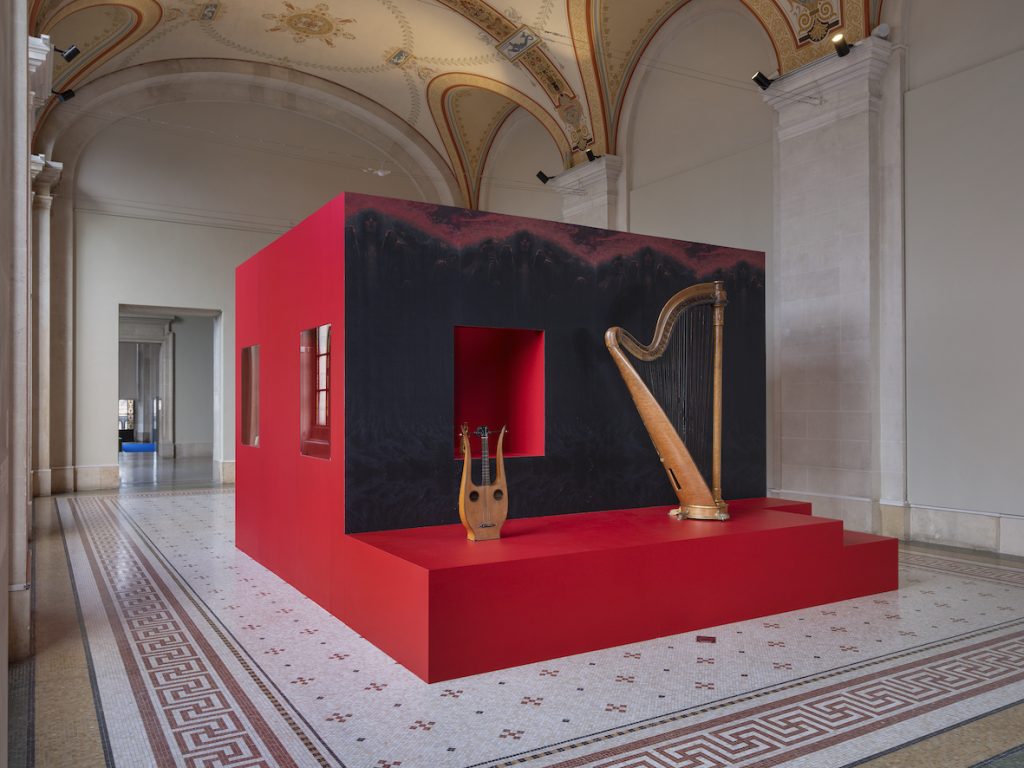
Jakob Lena Knebl at Geneva’s Museum of Art and History. Photo: Julien Gremaud.
The Geneva Museum has undertaken an ambitious new strategy to recontextualize its historic collection of artifacts and paintings that span centuries. No longer wanting to operate as an “authoritarian” encyclopedic museum, the Swiss institution is letting a contemporary artist reinterpret gems from its collection, starting with the Viennese artist Jakob Lena Knebl, who will represent Austria in 2022 at the Venice Biennale with her collaborator Ashley Hans Scheirl.
For her show “Walk on the Water,” Knebl went through the museum’s 650,000 objects and restaged items within colorful, surreal scenes. In one chapter, there is a statue of Ramses II, dating from around 1290 BC, in a plush modern bedroom. Elsewhere, neoclassical marbles of Venus stand in shower cubicles, and a pair of 18th-century silk shoes sits atop a food platter. It’s a refreshing take that dusts off and reinterprets a truly impressive collection.
Through July 25
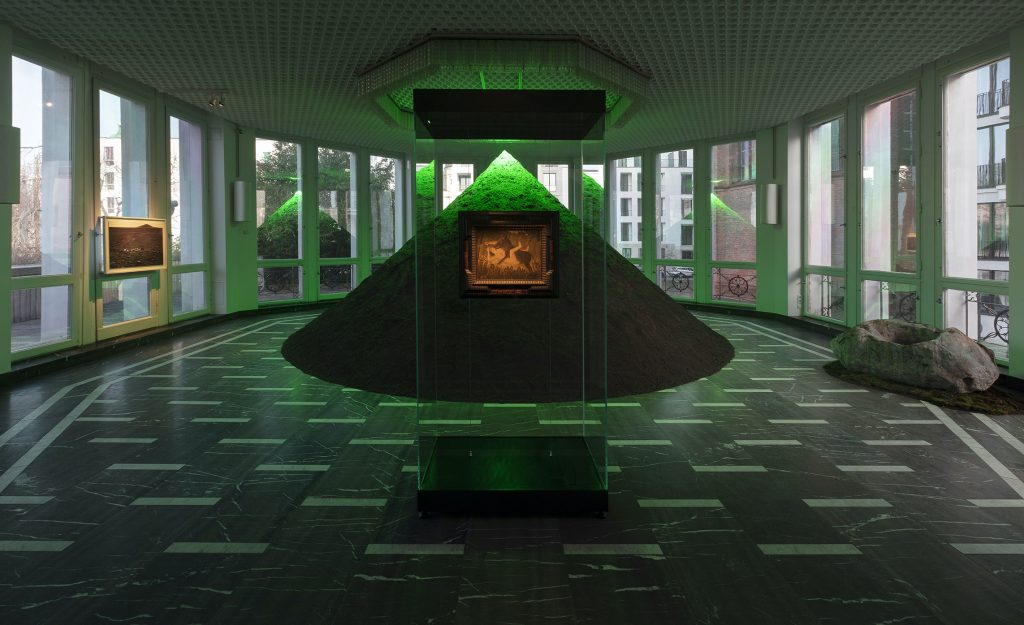
Installation view of “Sun Rise I Sun Set.” Photo: Andrea Rossetti.
A sensorial group show at Schinkel Pavillon in Berlin has artists like Max Ernst and Emma Kunz paralleled with contemporary figures including Pierre Huyghe or Norwegian photographer Torbjørn Rødland. A small green sprout is reaching out of the soil of Pamela Rosenkranz’s mound sculpture Infection (Calvin Klein Obsession for Men)—the cologne from the piece wafts around the glassed-in gallery space, which is tinted to protect light-shy earth worms that are fertilizing recent Frieze award winner Precious Okoyomon’s rock sculpture.
“Sun Rise | Sun Set” looks at climate as a poetic protagonist and, where individual humans do occur in this exhibition, they are inseparable from the natural world or at the mercy of it in some way. A woman is dominated by a beast in a 1908 painting by Henri Rousseau. Octopi tentacles seem to hit the sides of the screen as it swims in Kuwaiti filmmaker Monira al Qadiri’s moving work Divine Memory. The exhibition, with its flora and fauna that are both real and depicted, nearly transforms into its own feeling and breathing ecosystem.
Through July 25
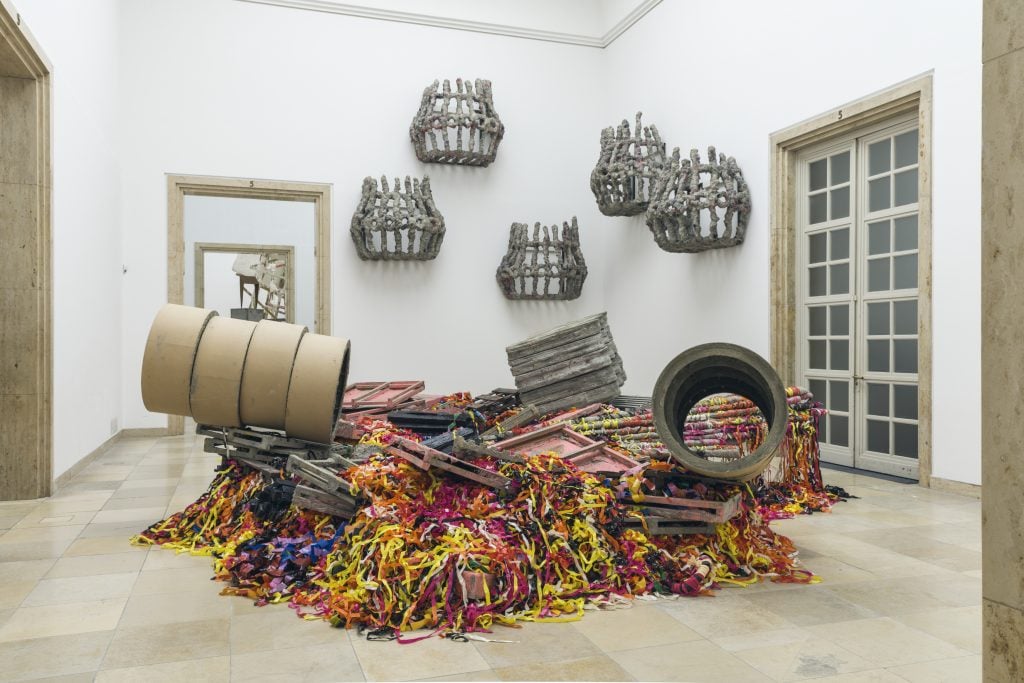
Installation view of “frontier” by Phyllida Barlow at Haus der Kunst, 2021. Photo: Maximilian Geuter.
The UK sculptor is having a large retrospective of 100 works that span decades of her practice. Barlow creates large-scale “anti-monumental” sculptures often from basic materials like cardboard, plywood, and textiles.
On the occasion of the show at Haus der Kunst—which launches a series of female-focused programming this year—Barlow has created several new site-specific works while reinstalling older pieces of towering proportions, dominating the museum’s intimidating architecture. There are also more intimate yet equally expressive works on paper that date back to the 1960s, which often share the same vivid color and energy as her sculptures. Considering that many of her works from earlier decades were destroyed, these works, which are usually made after a sculpture is complete, are somewhere between a memory and a dream.
Opening March 20
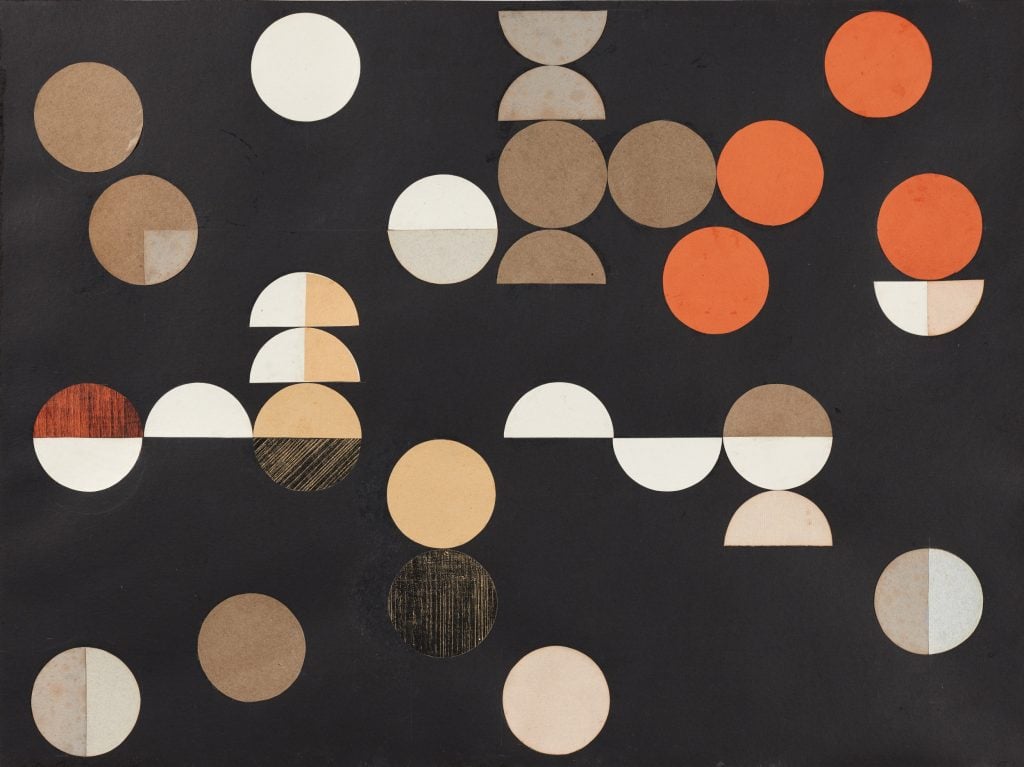
Sophie Taeuber-Arp; Composition à cercles et demi-cercles (1938). Arp Museum Bahnhof, Rolandseck, Remagen.
The Kunstmuseum Basel is giving Sophie Taeuber-Arp the recognition she deserves as a pioneer of 20th-century abstraction by staging a comprehensive retrospective of Switzerland’s own homegrown artist. The 250-work show, which has been put together in collaboration with MoMA in New York and Tate in London, includes her early works in applied arts and charts her brazen move into geometric abstraction, including her experimental years between Zurich and Paris, through to her later architectural works and abstract paintings.
“Living Abstraction” shines a full spotlight on an artist who has often been overshadowed in art history—though she has a special place in Switzerland, as many important collectors of her work are based there, and her face is on the 50 Swiss Franc note.